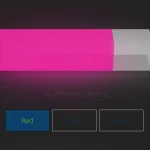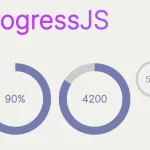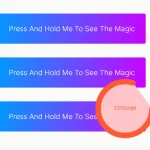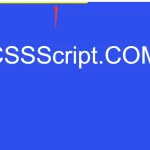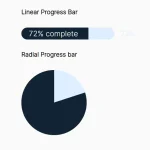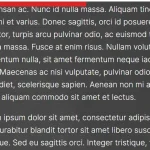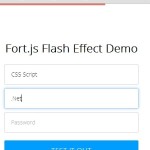| Author: | kimmobrunfeldt |
|---|---|
| Views Total: | 8,047 views |
| Official Page: | Go to website |
| Last Update: | January 18, 2020 |
| License: | MIT |
Preview:

Description:
ProgressBar.js is a modern JavaScript library to create animated, smooth, creative progress indicators using SVG.
The progress indicator plugin works with any shapes thanks to the SVG path animation.
Built-in shapes:
- Line
- Circle
- Semi-Circle
- Square
How to use it:
1. Install & download the package.
# NPM $ npm install progressbar.js --save
2. Import the main script progressbar.min.js from the dist folder.
<script src="./dist/progressbar.min.js"></script>
3. Create a container in which you’d like to draw the progress indicator.
<div id="example"></div>
4. The JavaScript to draw a progress indicator.
// circle
var myProgress = new ProgressBar.Circle('#example', {
// options here
});
// line
var myProgress = new ProgressBar.line('#example', {
// options here
});
// semi-circle
var myProgress = new ProgressBar.SemiCircle('#example', {
// options here
});
// square
var myProgress = new ProgressBar.Square('#example', {
// options here
});5. The library also provides a lower-level API to animate any kind of SVG path.
<svg xmlns="http://www.w3.org/2000/svg" version="1.1" x="0px" y="0px" viewBox="0 0 100 100"> <path fill-opacity="0" stroke-width="1" stroke="#bbb" d="M81.495,13.923c-11.368-5.261-26.234-0.311-31.489,11.032C44.74,13.612,29.879,8.657,18.511,13.923 C6.402,19.539,0.613,33.883,10.175,50.804c6.792,12.04,18.826,21.111,39.831,37.379c20.993-16.268,33.033-25.344,39.819-37.379 C99.387,33.883,93.598,19.539,81.495,13.923z"/> <path id="custom" fill-opacity="0" stroke-width="3" stroke="#ED6A5A" d="M81.495,13.923c-11.368-5.261-26.234-0.311-31.489,11.032C44.74,13.612,29.879,8.657,18.511,13.923 C6.402,19.539,0.613,33.883,10.175,50.804c6.792,12.04,18.826,21.111,39.831,37.379c20.993-16.268,33.033-25.344,39.819-37.379 C99.387,33.883,93.598,19.539,81.495,13.923z"/> </svg>
var custom = new ProgressBar.Path('#custom', {
// options here
});6. All possible options to customize the progress indicator.
// built-in shapes
var myProgress = new ProgressBar.Shape('#example', {
// Stroke color
color: '#555',
// Width of the stroke.
strokeWidth: 1.0,
// Color for lighter trail stroke
// underneath the actual progress path.
trailColor: '#eee',
// Width of the trail stroke.
trailWidth: 1.0,
// Inline CSS styles for the created SVG element
// Set null to disable all default styles.
// You can disable individual defaults by setting them to `null`
svgStyle: {
display: 'block',
width: '100%'
},
// Text options. Text element is a <p> element appended to container
// You can add CSS rules for the text element with the className
// NOTE: When text is set, 'position: relative' will be set to the
// container for centering. You can also prevent all default inline
// styles with 'text.style: null'
// Default: null
text: {
// Initial value for text.
// Default: null
value: 'Text',
// Class name for text element.
// Default: 'progressbar-text'
className: 'progressbar__label',
// Inline CSS styles for the text element.
// If you want to modify all CSS your self, set null to disable
// all default styles.
// If the style option contains values, container is automatically
// set to position: relative. You can disable behavior this with
// autoStyleContainer: false
// If you specify anything in this object, none of the default styles
// apply
// Default: object speficied below
style: {
// Text color.
// Default: same as stroke color (options.color)
color: '#f00',
position: 'absolute',
left: '50%',
top: '50%',
padding: 0,
margin: 0,
// You can specify styles which will be browser prefixed
transform: {
prefix: true,
value: 'translate(-50%, -50%)'
}
},
// Only effective if the text.style is not null
// By default position: relative is applied to container if text is set.
// Setting this to false disables that feature.
autoStyleContainer: true,
// Only effective if the shape is SemiCircle.
// If true, baseline for text is aligned with bottom of the SVG canvas.
// If false, bottom line of SVG canvas is in the center of text.
alignToBottom: true
},
// Fill color for the shape. If null, no fill.
fill: null,
// Duration for animation in milliseconds
duration: 800,
// Easing for animation.
// 'linear', 'easeIn', 'easeOut', 'easeInOut'
easing: 'linear',
// Built-in shape passes reference to itself and a custom attachment object to step function
from: { color: '#eee' },
to: { color: '#000' },
step: function(state, circle, attachment) {
circle.path.setAttribute('stroke', state.color);
},
// If true, some useful console.warn calls will be done if it seems that progressbar is used incorrectly
warnings: false
});
// custom SVG shapes
var custom = new ProgressBar.Path('#custom', {
// Duration for animation in milliseconds
duration: 1200,
// Easing for animation. See #easing section.
easing: 'easeIn',
// Attachment which can be any object you need to modify within the step function.
// Passed as a parameter to step function.
attachment: document.querySelector('#container > svg'),
// Custom animation
from: { color: '#eee' },
to: { color: '#000' },
step: function(state, path, attachment) {
// Do any modifications to attachment and/or path attributes
}
});7. API methods.
// SVG element instance.svg // SVG path instance.path // SVG path which presents the trail of the progress bar instance.trail // <p> element which presents the text label for progress bar instance.text // animate to a specific value (0-1) instance.animate(progress, [options], [cb]); // set a new value instance.set(progress); // stop the animation instance.stop(); // get the current value instance.value(); // set text instance.setText(text); // destroy the instance instance.destroy();



